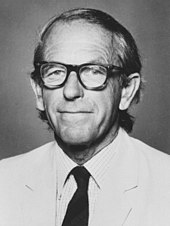1-fluoro-2,4-dinitrobenzene
| Structural formula | ||||||||||||||||
|---|---|---|---|---|---|---|---|---|---|---|---|---|---|---|---|---|

|
||||||||||||||||
| General | ||||||||||||||||
| Surname | 1-fluoro-2,4-dinitrobenzene | |||||||||||||||
| other names |
|
|||||||||||||||
| Molecular formula | C 6 H 3 FN 2 O 4 | |||||||||||||||
| Brief description |
pale yellow crystals |
|||||||||||||||
| External identifiers / databases | ||||||||||||||||
|
||||||||||||||||
| properties | ||||||||||||||||
| Molar mass | 186.10 g mol −1 | |||||||||||||||
| Physical state |
firmly |
|||||||||||||||
| density |
1.482 g cm −3 (25 ° C) |
|||||||||||||||
| Melting point | ||||||||||||||||
| boiling point |
296 ° C |
|||||||||||||||
| solubility |
soluble in benzene , diethyl ether and ethanol |
|||||||||||||||
| safety instructions | ||||||||||||||||
|
||||||||||||||||
| As far as possible and customary, SI units are used. Unless otherwise noted, the data given apply to standard conditions . | ||||||||||||||||
1-Fluoro-2,4-dinitrobenzene, or Sanger's reagent, is a yellow crystalline solid that is used for protein sequencing . The structure consists of a benzene ring with one fluorine (–F) and two nitro groups (–NO 2 ) as substituents . It belongs to a group of substances in which the different arrangement of the substituents results in six constitutional isomers .
History and representation
1-Fluoro-2,4-dinitrobenzene was first prepared by Holleman and Beekman in 1903. You got it by nitration of p -Fluornitrobenzol which they previously made p -Nitroanilin had shown. In 1936 Gottlieb presented a synthesis in which 1-chloro-2,4-dinitrobenzene was converted into nitrobenzene with potassium fluoride (KF).
Cook and Saunders introduced significant improvements to this method in 1947, based on a significant reduction in the amount of potassium fluoride and the work steps. They also heated 1-chloro-2,4-dinitrobenzene with anhydrous potassium fluoride in nitrobenzene at 190-195 ° C. The product was then purified by distillation. When using sodium fluoride (NaF) instead of potassium fluoride, however, practically no reaction was observed.
properties
1-Fluoro-2,4-dinitrobenzene is a yellow crystalline solid that melts at 25.8 ° C and boils at 296 ° C. It crystallizes in the orthorhombic crystal system in the space group P 2 1 2 1 2 1 (space group No. 19) with the lattice parameters a = 621.0 pm , b = 945 pm and c = 1285 pm and four formula units per unit cell .
use
In 1945 Frederick Sanger described the use of 1-fluoro-2,4-dinitrobenzene for the determination of the N -terminal amino acids in polypeptide chains, particularly in insulin . B. C. Saunders kindly made the chemical available to him, both of whom were working at the University of Cambridge in England at the time . Sanger's first results showed that insulin was a smaller molecule than previously thought ( molar mass 12,000 g · mol −1 ) and that it consisted of four chains (two ends with glycine and two ends with phenylalanine ). Sanger continued to work on insulin with dinitrofluorobenzene in combination with other techniques to finally achieve complete sequencing of the insulin (consisting of only two chains with a molar mass of 6000 g · mol −1 ). Because of this work, the substance was given the additional name Sanger's reagent .
After Sanger's initial publication, the dinitrofluorobenzene method was widely used for the study of proteins until it was superseded by other reagents for terminal analysis (e.g. dansyl chloride and later aminopeptidases and carboxypeptidases ) as well as other general methods of determining the sequence ( e.g. the Edman degradation ).
Individual evidence
- ↑ a b Entry on 1-fluoro-2,4-dinitrobenzene. In: Römpp Online . Georg Thieme Verlag, accessed on April 19, 2014.
- ↑ a b c Data sheet 1-Fluoro-2,4-dinitrobenzene from Sigma-Aldrich , accessed on March 17, 2011 ( PDF ).
- ↑ a b c David R. Lide (Ed.): CRC Handbook of Chemistry and Physics . 90th edition. (Internet version: 2010), CRC Press / Taylor and Francis, Boca Raton, FL, Physical Constants of Organic Compounds, pp. 3-260.
- ↑ European Pharmacopoeia , Deutscher Apotheker Verlag Stuttgart, 6th edition, 2008, p. 605, ISBN 978-3-7692-3962-1 .
- ^ AF Holleman , JW Beekman, Sur le fluorobenzène et quelques-unede ses dérivés , in: Rec. Trav. chim. Pays-Bas , 1904 , 23 , pp. 225-256 ( full text , there p. 240).
- ^ HB Gottlieb: The Replacement of Chlorine by Fluorine in Organic Compounds , in: J. Am. Chem. Soc. , 1936 , 58 (3), pp. 532-533 ( doi : 10.1021 / ja01294a502 ).
- ^ HG Cook, BC Saunders: 1: 2: 4-Fluorodinitrobenzene , in: Biochem. J. , 1947 , 41 (4), pp. 558-559 ( PMID 20270792 ; PMC 1258537 (free full text)).
- ↑ A. Wilkins, RWH Small: Structure of 1-fluoro-2,4-dinitrobenzene , in: Acta Cryst. , 1991 , C47 , pp. 220-221 ( doi : 10.1107 / S0108270190007326 ).
- ^ F. Sanger : The Free Amino Groups of Insulin , in: Biochem. J. , 1945 , 39 (5), pp. 507-515 ( PMID 16747948 ; PMC 1258275 (free full text)).
- ^ A b J. Fruton: Proteins, Enzymes, Genes: The Interplay of Chemistry and Biology . New Haven: Yale University Press, 1999, p. 216 ( limited preview in Google Book Search).
literature
- T. Schaefer: The Proton Magnetic Resonance Spectrum of 1-Fluoro-2,4-dinitrobenzene . In: Canadian Journal of Chemistry . 40 (3), 1961, pp. 431-433, doi : 10.1139 / v62-068 .
- BD Nageswara Rao: "The 1 H and 19 F Resonance Spectra of 1-Fluoro-2,4-dinitrobenzene", in: Molecular Physics , 1964 , 7 (4), pp. 307-310 ( doi : 10.1080 / 00268976300101071 ).
- Streitwieser / Heathcock : Organic Chemistry , 1st Edition, Verlag Chemie, Weinheim 1980, ISBN 3-527-25810-8 , pp. 996-997.
- Albert L. Lehninger : Biochemie , 2nd edition, Verlag Chemie, Weinheim 1983, ISBN 3-527-25688-1 , pp. 82-83.




